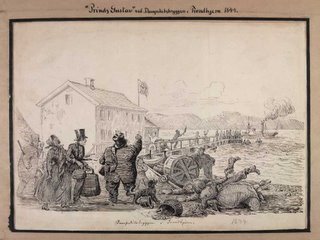




Selections from the Paris Music Hall Collection at University of Georgia Libraries, Hargrett Library. These are original sketches. Meeooow!
Addit: Hm. These look familiar. I don't think I've posted them or this site before.
























Publication note: The Spanish "Vancouver." Atlas volume only, first edition. Sometimes attributed to Dionisio Alcala Galiano. The title of the text volume is "Relacion del Viage Hecho por las Goletas Sutil y Mexicana en al ano 1792 para reconocer el estrecho de Fuca..." The last and very important voyage up the Pacific coast to be undertaken by Spain is detailed in the nine maps and eight plates of the atlas. Galiano and Cayetano Valdes led the expedition, arriving in the northwest at the same time as Vancouver. Although the maps were published four years after the Vancouver maps, Wagner considers them in many respects to be superior, and Humboldt used them in his Essai Politique sur le Royaume de la Nouvelle Espagne. Wagner further states: "The general impression today...is that the English discoveries of Vancouver were published four years before those of the Spaniards. This...is a misapprehension... The principal reason, however, why the nomenclature and geography of Vancouver came to occupy the field was that his maps were extensively copied by the famous English cartographer, Aaron Arrowsmith, and later by the English Admiralty." "







"Gradually people realize no more arts can express the continuity of culture, the concern of the development of human beings and its future than prints. Facing the development of prints, we try to record all the outstanding printmakers. Their artworks reflect the enterprising spirit and taste of beauty of human beings."











"Perhaps this very flirtation with the black arts was a source for titillation for the princely and religious audience of Kircher’s wonders – an audience directly involved in the persecution of popular magic during the same period – allowing them to experience the “armchair-thrills” of magic without being morally implicated. Jesuit theatrical productions during this period were particularly famous for their stage-machinery – convincing representations of hell were a speciality – and for their hard-hitting moral didacticism, both features that they shared with Kircher’s machinic-performances, as we have seen in the case of the Delphic oracle."In the preface to his 1657 treatise, Mechanica Hydraulico-Pneumatica, which is displayed in full at the Max Planck Institute's Archimides Project, Schott advises readers -
"There is, in the much-visited Museum (that we will soon publish in print) of the Most learned and truly famous Author mentioned above (i.e. Kircher), a great abundance of Hydraulic and Pneumatic Machines, that are beheld and admired with enormous delight of their souls by those Princes and literati who rush from all cities and parts of the world to see them, and who hungrily desire to know how they are made, and so that I can satisfy their desire to know the construction of the machines, I have undertaken to show the fabric, and almost the anatomy of all of the Machines in the said Museum, or already shown elsewhere by the same author."
 Since 1970, Donald Jackson (Senior Illuminator to the Queen of England’s Crown Office and an elected Fellow and past Chairman of the prestigious Society of Scribes and Illuminators) has expressed the desire to handwrite the bible and include illuminations. It would be the first undertaking of its kind since the invention of the printing press.
Since 1970, Donald Jackson (Senior Illuminator to the Queen of England’s Crown Office and an elected Fellow and past Chairman of the prestigious Society of Scribes and Illuminators) has expressed the desire to handwrite the bible and include illuminations. It would be the first undertaking of its kind since the invention of the printing press. It is appropriate that St Johns Benedictine Abbey, who have a 1500 year association with manuscripts (they still have significant holdings) should acquiesce to Jackson's wishes, and they formally commissioned the project in 1998/1999. Using calf vellum, handmade inks with quill and gilding and silver inlay work, Jackson began the monumental task with: "In the beginning was the word.." in March 2000.
It is appropriate that St Johns Benedictine Abbey, who have a 1500 year association with manuscripts (they still have significant holdings) should acquiesce to Jackson's wishes, and they formally commissioned the project in 1998/1999. Using calf vellum, handmade inks with quill and gilding and silver inlay work, Jackson began the monumental task with: "In the beginning was the word.." in March 2000. By May 2005, 4 of the 7 volumes had been completed. They measure some 16 x 25 inches and will number about 1100 pages when finished. There will be 160 illuminations whose content have been worked out by a team - "It is up to a committee of artists, medievalists, theologians, biblical scholars and art historians to create these theological stories for Donald Jackson, the artistic director of The Saint John’s Bible."
By May 2005, 4 of the 7 volumes had been completed. They measure some 16 x 25 inches and will number about 1100 pages when finished. There will be 160 illuminations whose content have been worked out by a team - "It is up to a committee of artists, medievalists, theologians, biblical scholars and art historians to create these theological stories for Donald Jackson, the artistic director of The Saint John’s Bible." They are not completely shunning modernity: "A computer is used to size text and define line breaks. These pages are laid out in full size spreads with sketches in position. Artists use these layouts to guide their work."
They are not completely shunning modernity: "A computer is used to size text and define line breaks. These pages are laid out in full size spreads with sketches in position. Artists use these layouts to guide their work."






